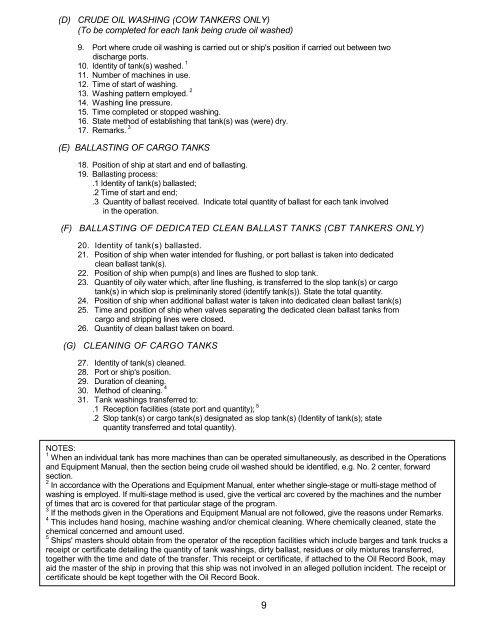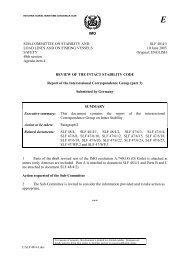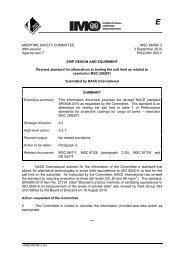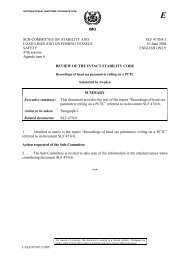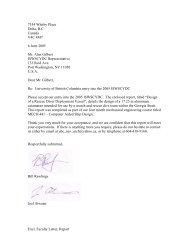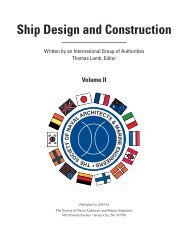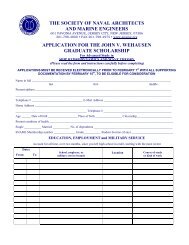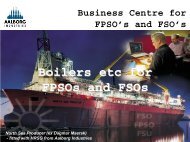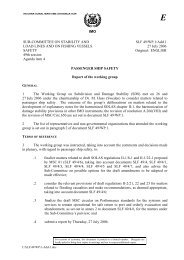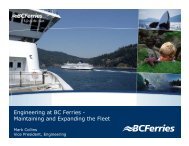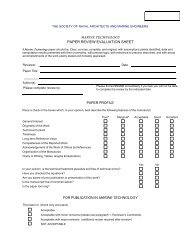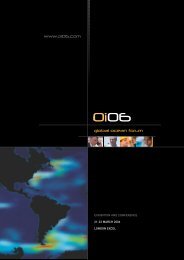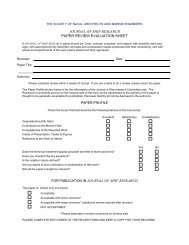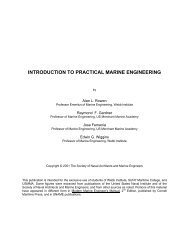new oil record book - SNAME.org
new oil record book - SNAME.org
new oil record book - SNAME.org
You also want an ePaper? Increase the reach of your titles
YUMPU automatically turns print PDFs into web optimized ePapers that Google loves.
(D) CRUDE OIL WASHING (COW TANKERS ONLY)<br />
(To be completed for each tank being crude <strong>oil</strong> washed)<br />
9. Port where crude <strong>oil</strong> washing is carried out or ship's position if carried out between two<br />
discharge ports.<br />
10. Identity of tank(s) washed. 1<br />
11. Number of machines in use.<br />
12. Time of start of washing.<br />
13. Washing pattern employed. 2<br />
14. Washing line pressure.<br />
15. Time completed or stopped washing.<br />
16. State method of establishing that tank(s) was (were) dry.<br />
17. Remarks. 3<br />
(E) BALLASTING OF CARGO TANKS<br />
18. Position of ship at start and end of ballasting.<br />
19. Ballasting process:<br />
.1 Identity of tank(s) ballasted;<br />
.2 Time of start and end;<br />
.3 Quantity of ballast received. Indicate total quantity of ballast for each tank involved<br />
in the operation.<br />
(F) BALLASTING OF DEDICATED CLEAN BALLAST TANKS (CBT TANKERS ONLY)<br />
20. Identity of tank(s) ballasted.<br />
21. Position of ship when water intended for flushing, or port ballast is taken into dedicated<br />
clean ballast tank(s).<br />
22. Position of ship when pump(s) and lines are flushed to slop tank.<br />
23. Quantity of <strong>oil</strong>y water which, after line flushing, is transferred to the slop tank(s) or cargo<br />
tank(s) in which slop is preliminarily stored (identify tank(s)). State the total quantity.<br />
24. Position of ship when additional ballast water is taken into dedicated clean ballast tank(s)<br />
25. Time and position of ship when valves separating the dedicated clean ballast tanks from<br />
cargo and stripping lines were closed.<br />
26. Quantity of clean ballast taken on board.<br />
(G) CLEANING OF CARGO TANKS<br />
27. Identity of tank(s) cleaned.<br />
28. Port or ship's position.<br />
29. Duration of cleaning.<br />
30. Method of cleaning. 4<br />
31. Tank washings transferred to:<br />
.1 Reception facilities (state port and quantity); 5<br />
.2 Slop tank(s) or cargo tank(s) designated as slop tank(s) (Identity of tank(s); state<br />
quantity transferred and total quantity).<br />
NOTES:<br />
1 When an individual tank has more machines than can be operated simultaneously, as described in the Operations<br />
and Equipment Manual, then the section being crude <strong>oil</strong> washed should be identified, e.g. No. 2 center, forward<br />
section.<br />
2 In accordance with the Operations and Equipment Manual, enter whether single-stage or multi-stage method of<br />
washing is employed. If multi-stage method is used, give the vertical arc covered by the machines and the number<br />
of times that arc is covered for that particular stage of the program.<br />
3 If the methods given in the Operations and Equipment Manual are not followed, give the reasons under Remarks.<br />
4 This includes hand hosing, machine washing and/or chemical cleaning. Where chemically cleaned, state the<br />
chemical concerned and amount used.<br />
5 Ships' masters should obtain from the operator of the reception facilities which include barges and tank trucks a<br />
receipt or certificate detailing the quantity of tank washings, dirty ballast, residues or <strong>oil</strong>y mixtures transferred,<br />
together with the time and date of the transfer. This receipt or certificate, if attached to the Oil Record Book, may<br />
aid the master of the ship in proving that this ship was not involved in an alleged pollution incident. The receipt or<br />
certificate should be kept together with the Oil Record Book.<br />
9


